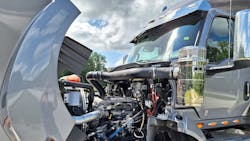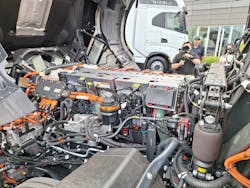Alternative fuels help heavy truck diesels dominate
“An explosion in economic activity” began when the pandemic mostly ended in 2021, and business has been brisk since, says Ken Vieth, president of ACT Research. Demand for heavy trucks was strong in 2022 and is more so this year. As of July, sales of all new Class 8 vehicles were up about 7% versus 2022, and vocational trucks have been the strongest segment.
A backlog of 6.5 months has persisted as demand for vocational trucks continues to outstrip production capacity and few new trucks sit on dealers’ lots. “Every truck being built has someone’s name on it,” Vieth says.
Read also: Who's who in heavy trucks in 2023
Meanwhile, to remain competitive, truck builders and their suppliers continue upgrading their products, making them more economical and productive for their owners and comfortable for their drivers. For example, automated manual transmissions now go into a big majority of highway tractors and full automatics have captured the market for many vocational trucks. Self-shifting transmissions save fuel, reduce maintenance, and relieve drivers of work so they can stay alert and safe.
Internal combustion engines (ICE), primarily diesels in heavy trucks, have become efficient and clean burning. Diesel continues to dominate the world of trucks and that will continue well into the 2030s. ICEs are too good to quickly throw away in favor of electric propulsion, according to industry observers and advisors. One is Mike Roeth, executive director of the North American Council on Freight Efficiency, who is bullish on electric vehicles but also realistic.
Read also: Terex Advance to use Cummins hydrogen engines
“While we at NACFE believe battery-electric trucks are the answer for the future—a position not everyone shares—we know the transition to battery-electric vehicles will take place over decades,” Roeth says. “Today, battery-electric trucks are not viable in many duty cycles, and even if they were, there are not enough of them being produced for fleets to make the switch.”
The Diesel Technology Forum actively promotes the advantages of diesels. Says its executive director, Allen Schaeffer, “Nearly 7 million new-technology diesel trucks are on the roads, delivering our goods and services with near-zero emissions. Nationwide, for every electric commercial truck on the road, there are nearly 1,100 powered by internal combustion engines.”
Recent research shows that internal combustion engines—primarily diesel and some gasoline—power 99.91% of the nation’s heavy trucks. As the trucking industry explores new fuels, along with battery-electric and fuel cell technology, it is clear that diesel and other internal combustion engines are going to continue to play a dominant role for many years.
CNG and LNG cost about half the price of diesel fuel, and prices have not fluctuated like diesel. Diesel-based engines modified with spark ignition do not need expensive exhaust-after- treatment gear. Less talked about was the multimillion-dollar cost of filling stations, plus on-board tanks and other equipment. Cost is high because natural gas must be compressed to 3,500 to 10,000 psi, or frozen to -259 F for liquification, to store at the stations and carry in extra-strong fuel tanks aboard trucks.
Compared to CNG, LNG contains many times the energy in a given tank size and provides more range, so it was tested by some major fleets. As a truck fuel, LNG has diminished in stature. CNG was adopted for use in trash-collection trucks that burn methane captured from landfills and cleansed. Thus their fuel is almost free. Environmentally conscious construction fleets have also swung to CNG to reduce exhaust emissions in their communities and gain positive recognition.
Natural gas as a truck fuel, and the truck models and engines to burn it, although garnering considerable industry attention and extensive publicity, never gained much actual use. Surveys quoted by the Diesel Technology Forum show that only 1.3% of current Class 8 heavy trucks use CNG, and diesels power 96.7%.
There are also “gray” and “blue” hydrogen: Both extract H2 by mixing natural gas with steam; the gray process also yields carbon dioxide (CO2), and the blue process captures that CO2.
For storage, hydrogen is pressurized to 10,000 psi to fill a tank. It can then be burned in an internal combustion engine, where its spark-induced combustion yields heat and power, as with other gaseous fuels. This combines today’s mechanical technology with tomorrow’s fuel, proponents say. Several hydrogen-burning engines are close to introduction, including a Cummins X15N, a Hyliion NG-electric hybrid, and a Westport Fuel Systems-Volvo model that requires use of LNG.
Hydrogen fuel cells may well become the eventual answer to long-haul trucking, where battery-electric trucks cannot store enough power for 500 or more miles, or any truck operation where battery charging from the grid is impractical or undesirable.
One development aimed at alternative fuels is Cummins’ Agnostic engine series. The company explains that a common engine block and lower end (pistons, connecting rods, crankshaft) are mated to cylinder heads designed for specific fuels. Hydrogen and biodiesel are among them.
Read also: Cummins approves use of unblended renewable diesel in high horsepower industrial engines
The first model is a 15-liter product based on the. Although aimed at off-road use, including construction equipment, the series might later find its way into heavy trucks. The concept will be extended to smaller 6.7- and 8.9-liter engines, Cummins says.
Electrification continues
Electric trucks feature brisk performance and near-silent operation, while promising low maintenance and life-cycle costs. All are expensive, though that can be offset by government grants.
Heavy and midrange electric trucks require charging serious infrastructure, however, and that can take two to three years to plan for and set up, according to fleets now involved in the electrification process. What kind of chargers and where to put them are among considerations.
Other considerations include: Where will the power come from? Can the grid and nearby substations and transformers support the new loads? Local utilities must be consulted and worked with, and/or self-sustaining solar or wind equipment with storage batteries obtained and installed. It’s all costly, but again, government subsidies are available. A nagging concern with electric vehicles is fires. Though rare, spontaneous combustion of li-ion batteries is dangerous and destructive, and the fires difficult to quench.
Scientists and engineers are working on safer and more advanced battery chemistries. Everyone involved insists that electric vehicles in general and electric trucks in particular are “the future,” and it’s getting closer. For a few forward-looking operators, it’s already here.
About the Author

Tom Berg
Tom Berg is widely acknowleged as one of the top truck writers in the industry. He has covered construction for more than 34 years, and has test-driven well over 150 trucks for Construction Equipment.


